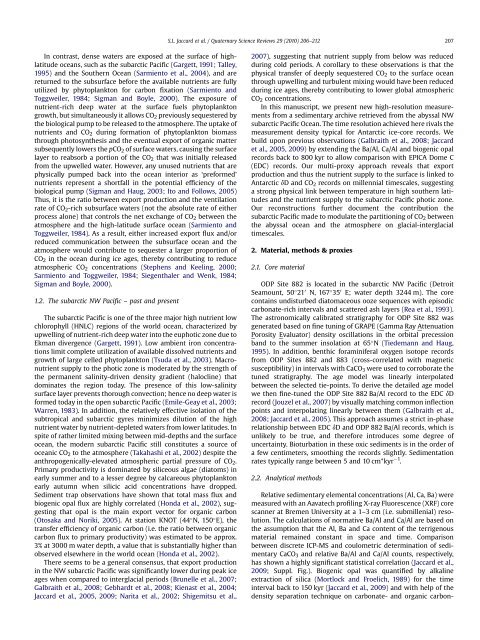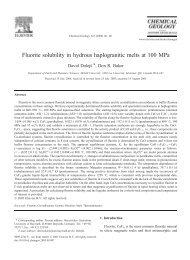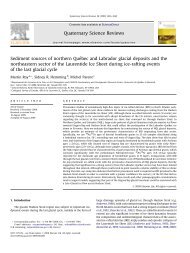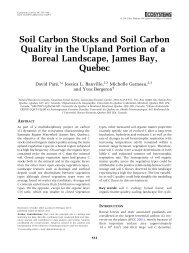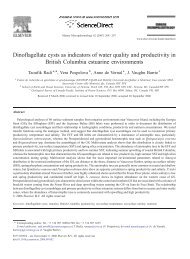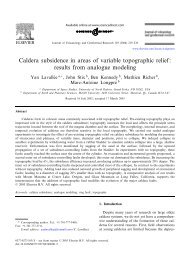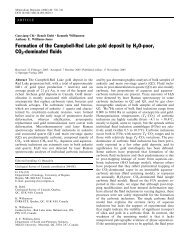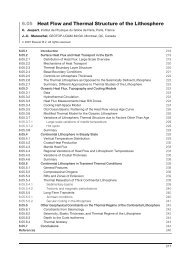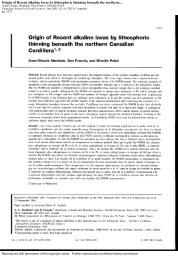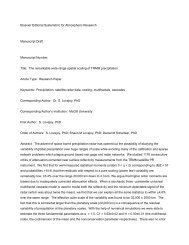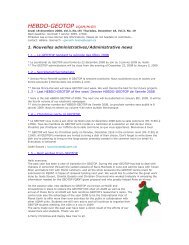A pervasive link between Antarctic ice core and subarctic Pacific ...
A pervasive link between Antarctic ice core and subarctic Pacific ...
A pervasive link between Antarctic ice core and subarctic Pacific ...
You also want an ePaper? Increase the reach of your titles
YUMPU automatically turns print PDFs into web optimized ePapers that Google loves.
S.L. Jaccard et al. / Quaternary Science Reviews 29 (2010) 206–212 207<br />
In contrast, dense waters are exposed at the surface of highlatitude<br />
oceans, such as the <strong>subarctic</strong> <strong>Pacific</strong> (Gargett, 1991; Talley,<br />
1995) <strong>and</strong> the Southern Ocean (Sarmiento et al., 2004), <strong>and</strong> are<br />
returned to the subsurface before the available nutrients are fully<br />
utilized by phytoplankton for carbon fixation (Sarmiento <strong>and</strong><br />
Toggweiler, 1984; Sigman <strong>and</strong> Boyle, 2000). The exposure of<br />
nutrient-rich deep water at the surface fuels phytoplankton<br />
growth, but simultaneously it allows CO 2 previously sequestered by<br />
the biological pump to be released to the atmosphere. The uptake of<br />
nutrients <strong>and</strong> CO 2 during formation of phytoplankton biomass<br />
through photosynthesis <strong>and</strong> the eventual export of organic matter<br />
subsequently lowers the pCO 2 of surface waters, causing the surface<br />
layer to reabsorb a portion of the CO 2 that was initially released<br />
from the upwelled water. However, any unused nutrients that are<br />
physically pumped back into the ocean interior as ‘preformed’<br />
nutrients represent a shortfall in the potential efficiency of the<br />
biological pump (Sigman <strong>and</strong> Haug, 2003; Ito <strong>and</strong> Follows, 2005)<br />
Thus, it is the ratio <strong>between</strong> export production <strong>and</strong> the ventilation<br />
rate of CO 2 -rich subsurface waters (not the absolute rate of either<br />
process alone) that controls the net exchange of CO 2 <strong>between</strong> the<br />
atmosphere <strong>and</strong> the high-latitude surface ocean (Sarmiento <strong>and</strong><br />
Toggweiler, 1984). As a result, either increased export flux <strong>and</strong>/or<br />
reduced communication <strong>between</strong> the subsurface ocean <strong>and</strong> the<br />
atmosphere would contribute to sequester a larger proportion of<br />
CO 2 in the ocean during <strong>ice</strong> ages, thereby contributing to reduce<br />
atmospheric CO 2 concentrations (Stephens <strong>and</strong> Keeling, 2000;<br />
Sarmiento <strong>and</strong> Toggweiler, 1984; Siegenthaler <strong>and</strong> Wenk, 1984;<br />
Sigman <strong>and</strong> Boyle, 2000).<br />
1.2. The <strong>subarctic</strong> NW <strong>Pacific</strong> – past <strong>and</strong> present<br />
The <strong>subarctic</strong> <strong>Pacific</strong> is one of the three major high nutrient low<br />
chlorophyll (HNLC) regions of the world ocean, characterized by<br />
upwelling of nutrient-rich deep water into the euphotic zone due to<br />
Ekman divergence (Gargett, 1991). Low ambient iron concentrations<br />
limit complete utilization of available dissolved nutrients <strong>and</strong><br />
growth of large celled phytoplankton (Tsuda et al., 2003). Macronutrient<br />
supply to the photic zone is moderated by the strength of<br />
the permanent salinity-driven density gradient (halocline) that<br />
dominates the region today. The presence of this low-salinity<br />
surface layer prevents thorough convection; hence no deep water is<br />
formed today in the open <strong>subarctic</strong> <strong>Pacific</strong> (Emile-Geay et al., 2003;<br />
Warren, 1983). In addition, the relatively effective isolation of the<br />
subtropical <strong>and</strong> <strong>subarctic</strong> gyres minimizes dilution of the high<br />
nutrient water by nutrient-depleted waters from lower latitudes. In<br />
spite of rather limited mixing <strong>between</strong> mid-depths <strong>and</strong> the surface<br />
ocean, the modern <strong>subarctic</strong> <strong>Pacific</strong> still constitutes a source of<br />
oceanic CO 2 to the atmosphere (Takahashi et al., 2002) despite the<br />
anthropogenically-elevated atmospheric partial pressure of CO 2 .<br />
Primary productivity is dominated by sil<strong>ice</strong>ous algae (diatoms) in<br />
early summer <strong>and</strong> to a lesser degree by calcareous phytoplankton<br />
early autumn when silicic acid concentrations have dropped.<br />
Sediment trap observations have shown that total mass flux <strong>and</strong><br />
biogenic opal flux are highly correlated (Honda et al., 2002), suggesting<br />
that opal is the main export vector for organic carbon<br />
(Otosaka <strong>and</strong> Noriki, 2005). At station KNOT (44 N, 150 E), the<br />
transfer efficiency of organic carbon (i.e. the ratio <strong>between</strong> organic<br />
carbon flux to primary productivity) was estimated to be approx.<br />
3% at 3000 m water depth, a value that is substantially higher than<br />
observed elsewhere in the world ocean (Honda et al., 2002).<br />
There seems to be a general consensus, that export production<br />
in the NW <strong>subarctic</strong> <strong>Pacific</strong> was significantly lower during peak <strong>ice</strong><br />
ages when compared to interglacial periods (Brunelle et al., 2007;<br />
Galbraith et al., 2008; Gebhardt et al., 2008; Kienast et al., 2004;<br />
Jaccard et al., 2005, 2009; Narita et al., 2002; Shigemitsu et al.,<br />
2007), suggesting that nutrient supply from below was reduced<br />
during cold periods. A corollary to these observations is that the<br />
physical transfer of deeply sequestered CO 2 to the surface ocean<br />
through upwelling <strong>and</strong> turbulent mixing would have been reduced<br />
during <strong>ice</strong> ages, thereby contributing to lower global atmospheric<br />
CO 2 concentrations.<br />
In this manuscript, we present new high-resolution measurements<br />
from a sedimentary archive retrieved from the abyssal NW<br />
<strong>subarctic</strong> <strong>Pacific</strong> Ocean. The time resolution achieved here rivals the<br />
measurement density typical for <strong>Antarctic</strong> <strong>ice</strong>-<strong>core</strong> records. We<br />
build upon previous observations (Galbraith et al., 2008; Jaccard<br />
et al., 2005, 2009) by extending the Ba/Al, Ca/Al <strong>and</strong> biogenic opal<br />
records back to 800 kyr to allow comparison with EPICA Dome C<br />
(EDC) records. Our multi-proxy approach reveals that export<br />
production <strong>and</strong> thus the nutrient supply to the surface is <strong>link</strong>ed to<br />
<strong>Antarctic</strong> dD <strong>and</strong> CO 2 records on millennial timescales, suggesting<br />
a strong physical <strong>link</strong> <strong>between</strong> temperature in high southern latitudes<br />
<strong>and</strong> the nutrient supply to the <strong>subarctic</strong> <strong>Pacific</strong> photic zone.<br />
Our reconstructions further document the contribution the<br />
<strong>subarctic</strong> <strong>Pacific</strong> made to modulate the partitioning of CO 2 <strong>between</strong><br />
the abyssal ocean <strong>and</strong> the atmosphere on glacial-interglacial<br />
timescales.<br />
2. Material, methods & proxies<br />
2.1. Core material<br />
ODP Site 882 is located in the <strong>subarctic</strong> NW <strong>Pacific</strong> (Detroit<br />
Seamount, 50 21 0 N, 167 35 0 E; water depth 3244 m). The <strong>core</strong><br />
contains undisturbed diatomaceous ooze sequences with episodic<br />
carbonate-rich intervals <strong>and</strong> scattered ash layers (Rea et al., 1993).<br />
The astronomically calibrated stratigraphy for ODP Site 882 was<br />
generated based on fine tuning of GRAPE (Gamma Ray Attenuation<br />
Porosity Evaluator) density oscillations in the orbital precession<br />
b<strong>and</strong> to the summer insolation at 65 N(Tiedemann <strong>and</strong> Haug,<br />
1995). In addition, benthic foraminiferal oxygen isotope records<br />
from ODP Sites 882 <strong>and</strong> 883 (cross-correlated with magnetic<br />
susceptibility) in intervals with CaCO 3 were used to corroborate the<br />
tuned stratigraphy. The age model was linearly interpolated<br />
<strong>between</strong> the selected tie-points. To derive the detailed age model<br />
we then fine-tuned the ODP Site 882 Ba/Al record to the EDC dD<br />
record (Jouzel et al., 2007) by visually matching common inflection<br />
points <strong>and</strong> interpolating linearly <strong>between</strong> them (Galbraith et al.,<br />
2008; Jaccard et al., 2005). This approach assumes a strict in-phase<br />
relationship <strong>between</strong> EDC dD <strong>and</strong> ODP 882 Ba/Al records, which is<br />
unlikely to be true, <strong>and</strong> therefore introduces some degree of<br />
uncertainty. Bioturbation in these oxic sediments is in the order of<br />
a few centimeters, smoothing the records slightly. Sedimentation<br />
rates typically range <strong>between</strong> 5 <strong>and</strong> 10 cm*kyr 1 .<br />
2.2. Analytical methods<br />
Relative sedimentary elemental concentrations (Al, Ca, Ba) were<br />
measured with an Aavatech profiling X-ray Fluorescence (XRF) <strong>core</strong><br />
scanner at Bremen University at a 1–3 cm (i.e. submillenial) resolution.<br />
The calculations of normative Ba/Al <strong>and</strong> Ca/Al are based on<br />
the assumption that the Al, Ba <strong>and</strong> Ca content of the terrigenous<br />
material remained constant in space <strong>and</strong> time. Comparison<br />
<strong>between</strong> discrete ICP-MS <strong>and</strong> coulometric determination of sedimentary<br />
CaCO 3 <strong>and</strong> relative Ba/Al <strong>and</strong> Ca/Al counts, respectively,<br />
has shown a highly significant statistical correlation (Jaccard et al.,<br />
2009; Suppl. Fig.). Biogenic opal was quantified by alkaline<br />
extraction of silica (Mortlock <strong>and</strong> Froelich, 1989) for the time<br />
interval back to 150 kyr (Jaccard et al., 2009) <strong>and</strong> with help of the<br />
density separation technique on carbonate- <strong>and</strong> organic carbon-


